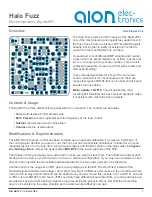
8
BIG MUFF PI / HALO FUZZ
Standard Wiring Diagram
This diagram shows standard true-bypass wiring
with a 3PDT switch. When the switch is off, the
input of the circuit is grounded and the input jack
is connected directly to the output jack.
The
SW
pad is the cathode connection for the
LED. This will connect to ground to turn it on
when the switch is on. Usage of the on-board
LED connection is not required if you have
specific placement needs for your enclosure,
but’s incredibly convenient.
The wiring diagram also makes use of
star
grounding
principles where all of the grounds
connect to a single ground point (in this case the
sleeve of the input jack). This is best practice
to avoid added noise caused by improper
grounding. The sleeve of the output jack is
unconnected.
If using a painted or powdercoated enclosure,
make sure both jacks have solid contact with
bare aluminum
for grounding purposes. You may
need to sand off some of the paint or powdercoat
on the inside in order to make this happen.
Make sure to double-check the markings of the
pads on the PCB for your particular project – they
are not always in the order shown here!
IN GND OUT SW
+9V
SLEEVE
TIP
TIP
License / Usage
No direct support is offered for these PCBs beyond the provided documentation.
It is assumed that you
have
at least some experience building pedals before starting one of these. Replacements and refunds will not
be offered unless it can be shown that the circuit or documentation are in error. I have in good faith tested all of
these circuits. However, I have not necessarily tested every listed modification or variation. These are offered
only as suggestions based on the experience and opinions of others.
Projects may be used for commercial endeavors in any quantity unless specifically noted.
No bulk
pricing or discounting is offered. No attribution is necessary, though a link back is always greatly appreciated.
The only usage restrictions are that
(1) you cannot resell the PCB as part of a kit
, and
(2) you cannot
“goop” the circuit, scratch off the screenprint, or otherwise obfuscate the circuit to disguise its source
.
(In other words: you don’t have to go out of your way to advertise the fact that you use these PCBs, but please
don’t go out of your way to hide it. The guitar effects pedal industry needs more transparency, not less!)


























